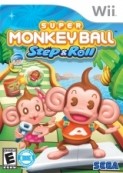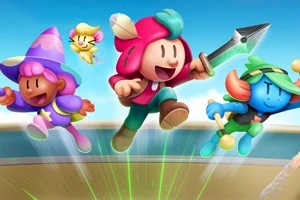Review: Super Monkey Ball: Step & Roll
Posted 23 Feb 2010 at 23:14 by Tom Phillips
Wii Review

| "It's like Sega are saying: "yes, we know these obstacles are annoying", but are also forcing you to have friend on hand to fix it." |
Monkey Ball. The game describes itself. A monkey in a ball, rolling around a level, trying to reach a goal. The series was born on Nintendo's previous console, the trusty little GameCube, and has since spawned several sequels. With this new entry into the series comes the expected new array of levels, a new line-up of mini-games, and support for Wii Fit's Balance Board controls.
In many ways, Step & Roll takes the series back to basics, eliminating many of the poorly conceived additions of its predecessor, Banana Blitz. Thankfully gone is the much riled-against ability to jump, as well as any attempt at a storyline (we're looking at you, Monkey Ball 2 and the evil Dr. Bad Boon) the boss fights (a nice idea, but there are really only so many ways a monkey in a ball can fight. If you disagree and can think of more, by all means, send them to Sega). A couple of levels even bring back the switches from Super Monkey Ball 2, although their use is (also, thankfully) more limited.
What Step & Roll's levels do have a lot of though is obstacles - many, many pillars (or Easter Island heads/rocks/chunks of ice, depending on the level's theming) you must navigate around and grooves in the floor, which your monkey can then roll along like a train on a track. As someone who has played all Monkey Ball games to date, the repeated use of these devices level, after level, after level, was kind of confusing. It makes the game's generally longer levels more about snaking your way through them in time than about actual accuracy, and in fact many are made so maze-like with obstacles it will take you more than one turn, or a good look at the level map, to work out your route.

The location of the goal is now highlighted on all maps - it can be that hard to find.
This design choice can only, this reviewer has concluded, have been implemented to accommodate the addition of the Balance Board controls. Gone are the hair-thin paths you must control your monkey around. Gone are the gaps in the floor to inch between. It's harder to "fall out" (which in this game is instead labelled "out of bounds"); instead the player finds him/herself more focused on dodging and winding around simpler levels at enough speed to reach the goal before the clock runs out.
More worrying still is the addition of a Co-Op mode, where the mess of pillars/rocks etc. can be blasted away by the second player. It's like Sega are saying: "yes, we know these obstacles are annoying", but are also forcing you to have friend on hand to fix this. You could try gripping a second Wii-mote between your knees to do this, but we're sure it wouldn't be very comfortable.
The main game has a different feel about it, but is not broken enough to be unplayable. It's irritating that Sega have had to change it so drastically though just to suit a control scheme we assume the majority of gamers will not be using. We couldn't really get used to Balance Board controls, and switched back to the Wii-mote early on. Earlier levels will take no time at all to beat, while later tracks still retain the teeth-grinding difficultly players of the series will remember. Another positive this time around is that you're given access to more worlds at a time. The game's 70 levels are divided into 7 worlds of 10 levels each. After beating World 1, you get both World 2 and 3 to beat at your leisure. There are also the usual options for replaying specific levels of your choice, plus the afore-mentioned co-op play and the new "marathon" mode - where you can try and undertake several worlds at a time - or even the full 70 levels. Once again, ten bananas equal an extra life, although Sega has removed probably the one good addition from Banana Blitz - making Bananas collectable items, which encouraged level replays to collect them all.

You think it looks bad here? These bloody statues prove a huge annoyance.
Mini-games have always played a big part in Monkey Ball, and once again Step & Roll has refined its predecessor's mistakes. Banana Blitz had something like 100, which was hugely overwhelming. While it is hard to complain when a developer puts too much into a game, it is valid to do so when you have to sort through 95 mini-wastes of space to find anything actually game-like and playable. It was like Sega had got their hands on the Wii-mote tech and in their excitement blown their budget on every possible fruit-sorting, UFO-landing, Whack-a-Monkey-playing conceit they could think of. This time around things are limited to about 20, with long-time classics Monkey Race and Monkey Target once again making a well-earned return. Of course, some are better than others (Monkey Jump Rope is even duller than it sounds), but Monkey Luge is rather entertaining, as is SeeSaw Ball, where you must descend a very Ice Climber-esque vertical stage, tilting each platform with your Wii-mote to direct your Monkey. Very addictive.
Graphics of the title retain their Banana Blitz look, and are perfectly adequate. Music-wise, the game really does excel however, as each World's background music is layered on level after level until the credits game, where you get the full song (hummable J-Pop tunes and the like). It's a neat little idea, and fits the game well.
Another chance to see the Monkey Ball gang is always welcome, although next time around we'd prefer less obstacles, and a further return to the classic level designs. Step & Roll reigns back some of the wackier elements of its predecessor (we're back just the original gang of four monkeys, too), but accommodation of the Balance Board has shifted gameplay in yet another unwelcome direction. It's not as good as the GameCube's original two titles, but Step & Roll can still be recommended for Monkey Ball newbies who won't be able to tell the difference, and long-term fans of the series who may be curious to see exactly what has changed.
N-Europe Final Verdict
While the game in some ways attempts to return to series roots, it changes yet again to accommodate an unwieldy new set of controls. The flawed result is not perfect, but playable.
- Gameplay3
- Playability3
- Visuals3
- Audio5
- Lifespan4
Final Score
7
Pros
More Monkey Ball levels to get angry at
Great music programming
Decent roster of minigames
Cons
Too many obstacles in levels
Earlier levels far too easy
Balance Board just not that accurate
























